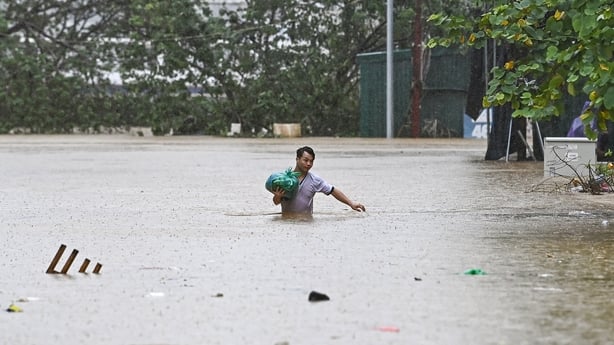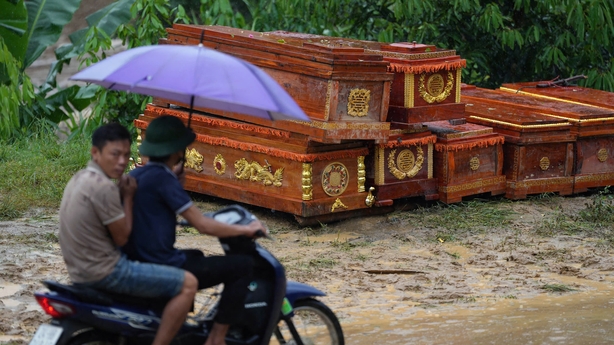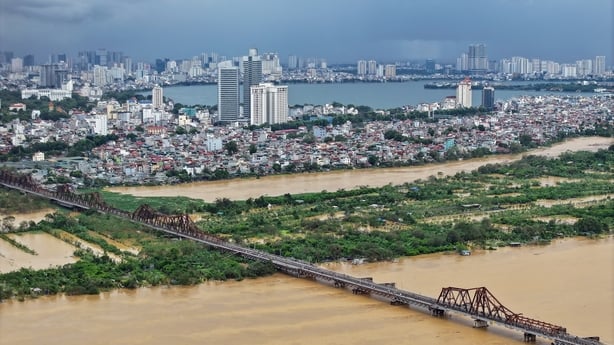The death toll in Vietnam from typhoon Yagi and the landslides and flash floods it triggered has risen to 226, the government's disaster agency said, as flood pressure eased in the capital Hanoi.
The south east Asian country is reeling from the impact of Typhoon Yagi, the strongest storm to hit Asia this year, which made landfall in Vietnam's northeastern coast on Saturday.
More than 100 people remain missing, while some 800 people have been injured, the agency said in a report.
Several districts in capital Hanoi remain flooded, but the weather agency said flood pressure has eased as the Red River had peaked in Hanoi and begun to subside.
North of the capital, landslides and severe floods are still affecting several areas, state media reported.
"There's a lot of heartbreak in the city and there was a lot of concern going into the evening," said charity Blue Dragon Children's Foundation co-CEO Skye Maconachie. "Many people who barely had anything have lost everything."
"I never thought my house would be under water this deep," said Hoang Van Ty outside his home in Thai Nguyen province.
"My clothes and furniture were all under the water. Many things were floating around too but luckily I closed the doors so nothing was washed away."
Hanoi residents have been forced to wade through waist-deep water, with neighbouring nations also enduring deadly flooding and landslides.
"This was the worst flooding I have witnessed," said Nguyen Tran Van, 41, who has lived near the Red River for 15 years.
"I didn't think the water would rise as quick as it did. I moved because if the water had risen just a bit higher, it would have been very difficult for us to leave," Van told AFP.
A landslide smashed into the remote mountain village of Lang Nu in Lao Cai province, levelling it to a flat expanse of mud and rocks strewn with debris and laced by streams.
State media said at least 34 people had been killed in the village, with another 46 still missing.

Villagers laid dead bodies on the ground, some in makeshift coffins, some wrapped in cloth, while police with picks and shovels dug through the dirt in search of more victims.
Vietnamese state media said the total death toll from Yagi - the strongest storm to hit northern Vietnam in 30 years - had risen to 179, with 145 missing across the country.
Worst floods since 2008
Mai Van Khiem, head of the national weather bureau, told state media that the water level in the Red River in Hanoi was at its highest since 2004.
Forecasters said the waters in Hanoi had peaked and the river level would go down, but Mr Khiem warned of serious widespread flooding in the provinces surrounding the capital in the days ahead.
Police, soldiers and volunteers helped hundreds of residents along the banks of the swollen river in Hanoi to evacuate their homes in the early hours as the water rose rapidly.
A police official in Hanoi, who refused to be identified, said officers were going on foot or by boat to check every house along the river.
"All residents must leave," he said. "We are bringing them to public buildings turned into temporary shelters or they can stay with relatives. There has been so much rain and the water is rising quickly."
Yesterday, pictures showed people stranded on rooftops and victims posted desperate pleas for help on social media, while 59,000 people were forced to evacuate their homes in Yen Bai province.
The United States is providing $1 million in immediate humanitarian aid to Vietnam, its embassy in Hanoi said.

Region-wide impact
In neighbouring Laos, authorities evacuated 300 people from 17 villages in northern Luang Namtha province, deputy district chief Sivilai Pankaew told AFP.
The UN's World Food Programme said it was "very concerned" for the safety of communities in northern Laos, while national radio reported extensive damage to houses, roads, markets, schools and farmland.
State media said at least one person had been killed and images showed rescuers working in murky brown floodwaters.
Thai authorities said four people were killed in the kingdom's northern provinces of Chiang Mai and Chiang Rai and the army had been deployed to help around 9,000 families hit by floods.
In Myanmar, days of rain around the sprawling low-rise capital Naypyidaw sent river levels to danger levels, the junta said in a statement.
Lay Shwe Zin Oo, from the ministry of social welfare, told AFP that casualties were expected but search teams were still gathering information.
Posts on social media showed people clinging to trees as the waters ran below them.
Southeast Asia experiences annual monsoon rains but human-made climate change is causing more intense weather patterns that can make destructive floods more likely.
Typhoons in the region are forming closer to the coast, intensifying more rapidly, and staying over land longer due to climate change, according to a study published in July.
Read more: Bridge collapses as Typhoon Yagi kills dozens in Vietnam

Lay Shwe Zin Oo, from the ministry of social welfare, told AFP that casualties were expected but search teams were still gathering information.
Posts on social media showed people clinging to trees as the waters ran below them.
Southeast Asia experiences annual monsoon rains but human-made climate change is causing more intense weather patterns that can make destructive floods more likely.
Typhoons in the region are forming closer to the coast, intensifying more rapidly, and staying over land longer due to climate change, according to a study published in July.


